
Explore nature-based solutions to climate change – innovative, sustainable strategies that use nature’s own processes to combat environmental challenges.
Nature-Based Solutions to Climate Change Key Takeaways:
- Nature-based solutions to climate change involve using natural processes and ecosystems, like forests, wetlands, and oceans, to mitigate the effects of climate change.
- These solutions focus on carbon sequestration, enhancing biodiversity, and improving ecosystem resilience, offering a sustainable approach to tackling environmental challenges.
Welcome to our deep dive into nature-based solutions to climate change!
As our planet faces increasing environmental challenges, turning to nature’s own toolbox offers a ray of hope.
Here, we’ll explore how leveraging natural processes and ecosystems can provide sustainable and effective solutions to mitigate climate change and protect our environment. Join us on this enlightening journey!
I. Introduction: Nature-Based Solutions to Climate Change
Understanding the Climate Change Challenge
The Reality of Climate Change:
- Our planet is undergoing significant changes due to climate change. Global temperatures have risen by about 1.2 degrees Celsius since the pre-industrial era, primarily due to human activities like burning fossil fuels.
- This warming is causing melting ice caps, rising sea levels, and more frequent and severe weather events like hurricanes and wildfires. These changes pose a threat to ecosystems, economies, and communities worldwide.
Sources of Greenhouse Gases:
- The primary drivers of climate change are greenhouse gases (GHGs), such as carbon dioxide (CO2), methane (CH4), and nitrous oxide (N2O).
- CO2, the most significant GHG, is mainly produced by burning fossil fuels for electricity, heat, and transportation.
- Deforestation and agricultural practices also contribute significantly to GHG emissions, releasing stored carbon into the atmosphere and reducing the earth’s capacity to absorb CO2.
Nature-Based Solutions (NbS): A Response to Climate Change
- Defining NbS: Nature-based solutions are actions that use natural processes to address societal challenges, including climate change.
- These solutions involve conserving, restoring, or better-managing ecosystems to absorb more CO2 from the atmosphere or to protect communities from climate impacts.
- NbS in Mitigating Climate Change: NbS like reforestation, wetland restoration, and sustainable agriculture can significantly mitigate climate change.
- For instance, forests absorb about one-third of the CO2 released from burning fossil fuels annually. Wetlands and peatlands are also crucial carbon sinks, storing vast amounts of carbon.
- Adaptation through NbS: NbS also plays a vital role in adaptation by reducing the impacts of climate change on communities and ecosystems.
- For example, restoring coastal ecosystems like mangroves can protect shorelines from storm surges and sea-level rise, while urban green spaces can reduce heat island effects in cities.
The Importance of NbS in Current Climate Strategies
- Integration in Global Policies: NbS are increasingly recognized in global climate policies.
- The Paris Agreement, for instance, emphasizes the importance of enhancing forest carbon stocks and calls for action on climate change that respects biodiversity.
- The Sustainable Development Goals (SDGs) also highlight the role of NbS in achieving environmental and societal targets.
- Benefits Beyond Carbon: Besides carbon sequestration, NbS offers a range of co-benefits. They support biodiversity, help purify water, reduce soil erosion, and provide economic opportunities for local communities through sustainable resource management and ecotourism.
- Future Outlook: The potential of NbS is vast, but realizing it requires integrating these solutions into broader climate and development policies, scaling up investment, and involving local communities in planning and implementation.
Summary
Climate change is a formidable challenge, but Nature-Based Solutions offer a pathway to mitigate its effects and adapt to its impacts.
By harnessing the power of ecosystems, we can not only reduce greenhouse gas emissions but also build a more resilient, biodiverse, and sustainable future.
The success of NbS, however, hinges on global cooperation, inclusive policies, and sustainable practices.
II. Understanding Nature-Based Solutions
Exploring the roots and principles of Nature-Based Solutions (NbS) is like uncovering a hidden map to sustainable living.
NbS isn’t just a modern concept; it’s a time-honored approach that involves using nature’s own methods to tackle environmental challenges.
From the ancient wisdom of indigenous practices to contemporary environmental strategies, NbS has evolved to become a cornerstone of our fight against climate change.
In this section, we’ll dive into what NbS really means, its historical journey, and the key principles that make it an effective tool for a healthier planet.
Definition of NbS
- Nature-Based Solutions Explained: Nature-Based Solutions (NbS) refer to the sustainable management and use of natural systems to address societal challenges, particularly environmental issues like climate change.
- This approach involves actions like ecosystem restoration, conservation, and sustainable land and water management, leveraging natural processes to mitigate climate change impacts, enhance biodiversity, and support ecosystem services.
Historical Context and Evolution of the Concept
- Origins and Evolution: The concept of NbS, rooted in traditional and indigenous practices, has gained modern recognition in environmental policy and science.
- Initially focusing on conservation, NbS has expanded to include ecosystem restoration, landscape management, and urban green spaces, reflecting a growing understanding of the role of nature in addressing environmental challenges.
Key Principles of NbS
- Core Principles: NbS are based on sustainability, biodiversity conservation, enhancement of ecosystem services, socio-economic benefits, and community involvement and equity.
- These principles ensure that NbS not only addresses environmental issues but also provides social and economic advantages, respecting the needs and rights of local communities.
Summary
Nature-based solutions embody a holistic approach to environmental challenges, blending traditional knowledge with modern scientific understanding.
This section provides a foundation for appreciating the role of NbS in shaping sustainable environmental policies and practices.
III. The Role of Ecosystems in Climate Mitigation
Ecosystems play a superhero role in our planet’s climate story. They’re not just scenic backdrops or habitats for wildlife; they are active players in climate mitigation.
Forests, wetlands, and ocean ecosystems like seagrasses, mangroves, and coral reefs do something extraordinary: they capture and store carbon, a process known as carbon sequestration.
In this section, we’ll explore how these natural systems help mitigate climate change and why protecting them is crucial for our future.
Forests as Carbon Sinks: Understanding Carbon Sequestration
- Forests and Climate Mitigation: Forests are among the most efficient carbon sinks on Earth. They absorb carbon dioxide from the atmosphere through photosynthesis, converting it into biomass. Mature forests, in particular, are vital, storing large amounts of carbon in their biomass and soil.
- The Role of Forests in Global Carbon Budgets: It’s estimated that forests absorb about one-third of the CO2 released from burning fossil fuels annually. This makes them critical in balancing the global carbon budget and mitigating climate change.
- Threats to Forest Carbon Sinks: Deforestation and forest degradation pose significant threats to these natural carbon sinks. Protecting and sustainably managing forests are therefore key strategies in climate change mitigation.
Wetlands and Their Role in Carbon Storage
- Wetlands as Carbon Storage Powerhouses: Wetlands, including marshes, peatlands, and swamps, are highly effective at storing carbon. They accumulate organic matter in their waterlogged soils, which decompose slowly, locking away carbon for centuries.
- The Significance of Wetlands in the Carbon Cycle: Wetlands store more carbon per unit area than most other types of ecosystems. This makes them exceptionally important in mitigating climate change, despite covering a relatively small proportion of the Earth’s surface.
- Conservation Challenges: Wetlands are under threat from drainage, pollution, and development. Conserving existing wetlands and restoring degraded ones are critical for maintaining their carbon storage capacity.
Ocean Ecosystems: Seagrasses, Mangroves, and Coral Reefs
- Seagrasses and Carbon Sequestration: Seagrass meadows are efficient at sequestering carbon in their sediments. They are estimated to store up to twice the amount of carbon per hectare as terrestrial forests.
- Mangroves: Coastal Guardians and Carbon Sinks: Mangroves store significant amounts of carbon in their rich, organic soils. They also protect coastlines from erosion and storm surges, providing additional climate adaptation benefits.
- Coral Reefs and Climate Change: While not significant carbon sinks, coral reefs play a vital role in supporting marine biodiversity and protecting shorelines. However, they are highly sensitive to climate change, particularly ocean warming and acidification.
The Role of Ecosystems in Climate Mitigation Table
This table summarizes the different types of ecosystems, their role in carbon sequestration, and their benefits for biodiversity and human communities.
| Ecosystem Type | Role in Carbon Sequestration | Biodiversity Benefits | Benefits for Human Communities |
|---|---|---|---|
| Forests | Absorb CO2 through photosynthesis; store carbon in biomass and soil | Habitat for diverse species; supports ecosystem services | Climate regulation; resources for livelihoods |
| Wetlands | Store carbon in waterlogged soils; slow decomposition locking away carbon | Crucial habitats for aquatic and bird species | Water purification; flood control |
| Ocean Ecosystems (Seagrasses, Mangroves) | Efficient at sequestering carbon in sediments (seagrasses); store carbon in soils (mangroves) | Support marine biodiversity; protect coastlines | Coastal protection; supports fisheries and tourism |
Summary
The role of ecosystems in climate mitigation cannot be overstated.
Forests, wetlands, and ocean ecosystems like seagrasses and mangroves are nature’s climate solutions, offering efficient and cost-effective means to capture and store carbon.
Their protection and restoration are essential steps in our global efforts to combat climate change and preserve the planet for future generations.
This section explores the crucial role of various ecosystems in mitigating climate change through soil carbon storage.
IV. Biodiversity and NbS
The tapestry of life on Earth, known as biodiversity, is inextricably linked to the health of our planet and the efficacy of Nature-Based Solutions (NbS).
Biodiversity, the variety of life in all its forms, plays a critical role in maintaining ecosystems that are vital for climate stability.
In this section, we delve into how biodiversity intertwines with climate change, examine successful case studies of biodiversity conservation through NbS, and address the challenges and opportunities in preserving our planet’s biological diversity.
The Interconnection between Biodiversity and Climate Change
- Biodiversity’s Role in Climate Regulation: Biodiverse ecosystems are more resilient and effective in carbon sequestration. Diverse forests, for instance, can store more carbon than monocultures.
- Impact of Climate Change on Biodiversity: Climate change poses a significant threat to biodiversity, leading to habitat loss, altered species distributions, and increased extinction rates.
- Mutual Reinforcement: The protection of biodiversity and climate mitigation efforts reinforce each other. Conserving biodiversity helps in climate change mitigation and adaptation, while a stable climate is crucial for maintaining biodiversity.
Case Studies: Successful Biodiversity Conservation through NbS
- Tropical Forest Restoration: The restoration of tropical forests, such as in the Brazilian Amazon, has shown significant biodiversity benefits along with carbon sequestration. These efforts have led to the return of various species and the enhancement of ecosystem services.
- Community-led Conservation in Africa: Community conservancies in Kenya, like the Northern Rangelands Trust, have successfully combined wildlife conservation with climate change mitigation, leading to improved livelihoods and biodiversity conservation.
- Urban Biodiversity Projects: Cities like Singapore have integrated NbS into urban planning, creating green spaces that support urban wildlife and contribute to city cooling, illustrating how NbS can enhance biodiversity in urban settings.
Read more: Nature-Based Solutions for Cities
Challenges and Opportunities in Biodiversity Conservation
- Balancing Human Needs and Conservation: One of the biggest challenges is balancing biodiversity conservation with the economic and developmental needs of human populations.
- Integrating Indigenous Knowledge: Recognizing and integrating the traditional knowledge of Indigenous peoples and local communities can enhance biodiversity conservation efforts.
- Technological and Scientific Advances: Advances in science and technology, like remote sensing and bioinformatics, offer new opportunities for monitoring and managing biodiversity.
- Policy Integration and Funding: Effective biodiversity conservation through NbS requires integrated policies that recognize the interconnectedness of climate change and biodiversity, along with adequate funding and investment.
Summary
The preservation of biodiversity is not just about saving species; it’s about maintaining the intricate balance of life that sustains our planet.
By implementing NbS with a focus on biodiversity, we can create a win-win scenario for the environment and humanity, addressing the dual crises of biodiversity loss and climate change.
This section highlights the vital connection between biodiversity and NbS, showcasing successful examples and discussing the challenges and opportunities in biodiversity conservation.
V. NbS in Action: Global Examples
Around the globe, Nature-Based Solutions are being implemented with remarkable success.
These initiatives, ranging from vast reforestation projects to coastal restoration efforts, demonstrate the potential of NbS to create significant environmental impacts.
This section showcases some notable global examples of NbS, highlighting their achievements and the lessons they offer for future projects.
Reforestation Efforts and Their Impact: The Great Green Wall in Africa
- The Great Green Wall Initiative: Launched in 2007, the Great Green Wall aims to combat the effects of climate change and desertification in the Sahel region of Africa. Spanning 11 countries, this ambitious project seeks to restore 100 million hectares of degraded land by 2030.

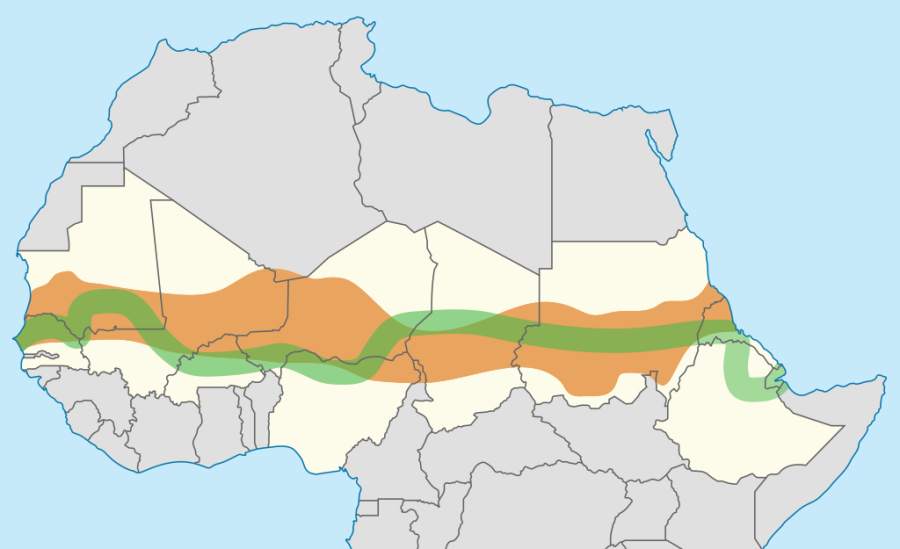
- Impact on Climate and Communities: The project has not only contributed to carbon sequestration but also enhanced food security, created jobs, and increased resilience to climate change for local communities. By 2020, around 18 million hectares of land were reportedly restored, demonstrating the transformative power of large-scale reforestation efforts.
Coastal Restoration Projects: Mangrove Restoration in Southeast Asia
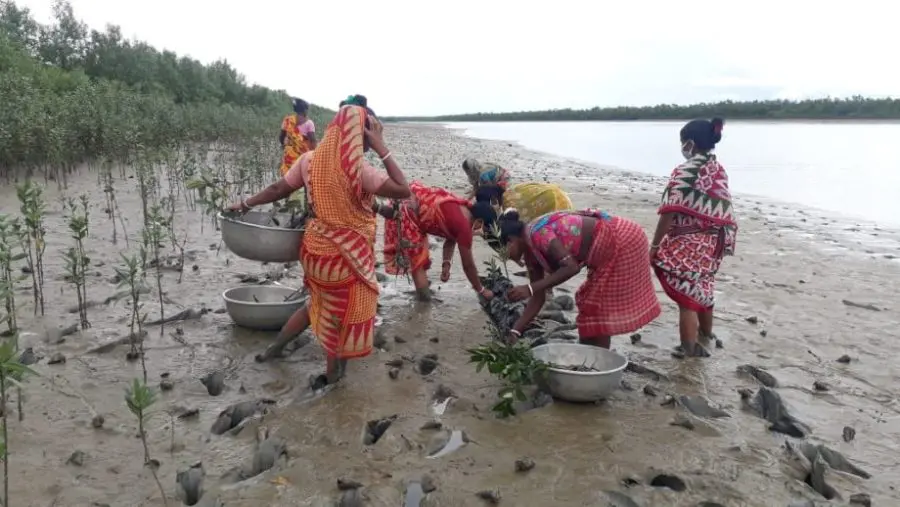
- Mangrove Restoration Efforts: In countries like Indonesia and the Philippines, mangrove restoration projects have been crucial in protecting coastal communities and ecosystems. Mangroves are not only effective carbon sinks but also provide critical habitat for marine life and protect shorelines from erosion and storm surges.
- Success Stories and Benefits: These projects have shown remarkable success in reviving degraded mangrove forests, enhancing biodiversity, and providing livelihood opportunities for local communities through sustainable fishing and ecotourism.
Urban Green Spaces and Their Climate Benefits
- Greening Urban Environments: Cities worldwide are integrating green spaces to combat urban heat islands and improve air quality. Parks, green roofs, and urban forests are becoming essential components of city planning.

- Climate and Health Benefits: These urban green spaces have been shown to lower temperatures, reduce energy consumption, improve air quality, and provide recreational areas for city dwellers. For example, the High Line in New York City and the Gardens by the Bay in Singapore are iconic examples of urban NbS providing both environmental and social benefits.
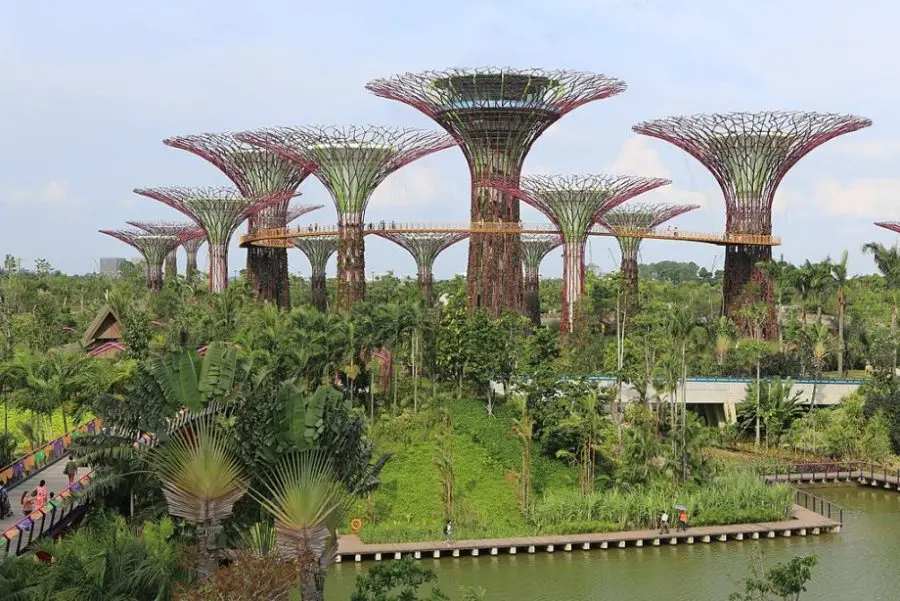
Summary
These global examples of NbS demonstrate their effectiveness in addressing environmental challenges while offering economic and social benefits.
From the vast stretches of the Great Green Wall in Africa to the intricate mangrove ecosystems in Southeast Asia and the vibrant urban green spaces in cities, NbS are proving to be versatile and impactful solutions for a sustainable future.
This section showcases global examples of successful Nature-Based Solutions and their impacts on the environment and communities.
VI. Socio-Economic Benefits of NbS
Nature-based solutions (NbS) are not only environmental safeguards; they are also engines of socio-economic development.
From creating jobs and fostering economic growth to supporting sustainable agriculture and empowering communities, NbS offers a range of benefits that go beyond mere ecological gains.
This section explores the multifaceted socio-economic advantages of NbS, underscoring their role in building sustainable and resilient societies.
Job Creation and Economic Development through NbS Projects
- Employment Opportunities: NbS projects, such as reforestation and wetland restoration, often require significant labor, thus creating numerous job opportunities. For instance, the restoration and management of natural landscapes have been shown to generate more jobs per dollar invested compared to traditional, non-green industries.
- Economic Growth: Beyond job creation, NbS contribute to economic growth by enhancing ecosystem services that support industries like agriculture, fisheries, and tourism. Healthy ecosystems ensure the sustainability of these industries, providing long-term economic benefits.
The Role of NbS in Sustainable Agriculture and Food Security
- Enhancing Agricultural Sustainability: NbS can transform agricultural practices, making them more sustainable and resilient to climate change. Agroforestry, for example, integrates trees into agricultural landscapes, improving soil health, increasing biodiversity, and enhancing crop resilience.
- Food Security: By improving soil quality, water availability, and pollination services, NbS contribute to higher crop yields and food security. Sustainable agricultural practices also reduce dependence on chemical fertilizers and pesticides, promoting healthier and more resilient food systems.
Community Involvement and Indigenous Knowledge in NbS
- Empowering Local Communities: Effective implementation of NbS often involves active participation from local communities. This engagement ensures that projects are tailored to local needs and conditions, increasing their success rate and sustainability.
- Integrating Indigenous Knowledge: Indigenous peoples possess a wealth of knowledge about their local ecosystems. Incorporating this traditional ecological knowledge into NbS projects can lead to more effective and culturally appropriate solutions.
- For example, Indigenous practices in forest management and conservation have been key in preserving biodiversity and ecosystem services in various regions around the world.
Summary
The socio-economic benefits of NbS highlight their role as a holistic approach to addressing environmental, social, and economic challenges.
By creating jobs, supporting sustainable agriculture, and involving communities, NbS is pivotal in building a more sustainable and equitable future.
This section outlines the socio-economic benefits of Nature-Based Solutions, emphasizing their role in job creation, sustainable agriculture, and community involvement.
VII. Challenges and Limitations of NbS
While Nature-Based Solutions (NbS) offer a range of benefits, they also come with their own set of challenges and limitations.
Addressing these challenges is crucial for ensuring the effectiveness and sustainability of NbS.
This section delves into the complexities of balancing conservation with development, mitigating potential negative impacts, and ensuring equitable access to the benefits of NbS.
Balancing Conservation and Development Needs
- Complex Trade-offs: One of the primary challenges is balancing environmental conservation with socio-economic development. For instance, establishing protected areas might conflict with local development needs, such as agriculture or housing.
- Integrated Planning Approaches: Achieving this balance requires integrated land-use planning that considers both conservation goals and the socio-economic needs of local communities. This might involve creating buffer zones, promoting eco-friendly development, or finding alternative livelihood options for affected communities.
Addressing Potential Negative Impacts
- Unintended Consequences of NbS: Some NbS can have unintended negative impacts. For example, large-scale reforestation with monocultures can reduce biodiversity and disrupt local ecosystems.
- Promoting Ecological Diversity: To mitigate such impacts, it’s important to prioritize ecological diversity in NbS projects. This means using a variety of native species in reforestation efforts and ensuring that restored ecosystems mimic the natural diversity of the region.
Ensuring Equitable Access and Benefits
- Inequities in NbS Implementation: Often, the benefits of NbS, such as improved air quality or flood protection, are not equally accessible to all segments of society. Vulnerable communities, particularly in developing countries, might not reap the same level of benefits.
- Strategies for Equitable NbS: Ensuring equitable access to the benefits of NbS requires targeted policies and community engagement. This includes involving local communities in decision-making processes, understanding their specific needs, and designing NbS projects that address these needs while ensuring fair distribution of benefits.
Table for the Challenges and Limitations of NbS
This table highlights the main challenges and limitations of NbS, along with potential solutions or strategies to address them.
| Challenge / Limitation | Description | Potential Solutions / Strategies |
|---|---|---|
| Balancing Conservation and Development | Balancing environmental goals with socio-economic development needs | Integrated land-use planning; community involvement |
| Negative Impacts (e.g., monocultures in reforestation) | Unintended ecological consequences | Promote ecological diversity; use native species |
| Equitable Access and Benefits | Ensuring that NbS benefits are accessible to all, especially vulnerable communities | Targeted policies; community engagement and empowerment |
Summary
Addressing the challenges and limitations of NbS is critical for their long-term success.
By carefully considering the balance between conservation and development, mitigating potential negative impacts, and ensuring equitable access to benefits, NbS can be optimized to provide sustainable and inclusive solutions to environmental and social challenges.
This section covers the challenges and limitations of Nature-Based Solutions, emphasizing the need for balanced, inclusive, and ecologically sensitive approaches.
VIII. Policy and Financing for NbS
The success of Nature-Based Solutions (NbS) hinges significantly on supportive policies and robust financing mechanisms.
From international agreements to local initiatives, policy frameworks play a critical role in facilitating NbS.
Likewise, funding and investment are crucial in bringing these solutions to scale.
This section examines the landscape of policies and financing for NbS, including the role of the private sector and non-governmental organizations (NGOs).
Overview of International Policies Supporting NbS
- The Paris Agreement: The Paris Agreement, a landmark international treaty on climate change, recognizes the role of forests in mitigating climate change and includes mechanisms such as REDD+ (Reducing Emissions from Deforestation and Forest Degradation) to incentivize forest conservation.
- Conferences of the Parties (COP) Contributions: Various COP conferences under the United Nations Framework Convention on Climate Change (UNFCCC) have highlighted the importance of NbS in climate action plans. These conferences facilitate international collaboration and help set global agendas for implementing NbS.
Funding Mechanisms and Investment Opportunities for NbS
- Public and International Financing: Organizations like the Global Environment Facility (GEF) and the Green Climate Fund (GCF) provide critical funding for NbS projects, especially in developing countries. These funds often support large-scale initiatives like reforestation and wetland restoration.
- Innovative Financing Models: There’s a growing trend towards innovative financing mechanisms like green bonds, carbon credits, and payment for ecosystem services (PES) schemes. These models offer new ways to fund NbS while promoting sustainable development.
The Role of the Private Sector and NGOs in Advancing NbS
- Private Sector Engagement: Corporations are increasingly investing in NbS, driven by corporate social responsibility (CSR) goals, carbon offsetting, and sustainability strategies. This investment not only aids in climate action but can also enhance corporate reputation and stakeholder relations.
- NGOs as Catalysts for NbS: NGOs play a pivotal role in advancing NbS, from advocating for supportive policies to implementing grassroots projects. They often act as bridges between local communities, governments, and international bodies, ensuring that NbS are effectively implemented and managed.
Summary
Effective policy frameworks and diverse financing streams are essential for the successful implementation and scaling of NbS.
The combined efforts of international bodies, governments, the private sector, and NGOs are crucial in harnessing the full potential of NbS for climate action and sustainable development.
This section covers the critical aspects of policy and financing that support Nature-Based Solutions, including the roles of various stakeholders.
IX. Technological Innovations in NbS
The integration of technology in Nature-Based Solutions (NbS) is revolutionizing how we monitor, measure, and enhance these initiatives.
Technological advancements are enabling more precise and efficient management of ecosystems, making NbS more effective and scalable.
This section explores the key technological innovations that are supporting NbS, from monitoring impacts to aiding in restoration efforts.
Advances in Monitoring and Measuring the Impact of NbS
- Data-Driven Impact Assessment: Technologies like satellite imagery and data analytics are crucial for monitoring the environmental impact of NbS projects. They provide valuable insights into carbon sequestration levels, biodiversity changes, and ecosystem health.
- Real-Time Monitoring Systems: Advanced sensors and IoT (Internet of Things) devices offer real-time monitoring capabilities, enabling quicker responses to environmental changes and more effective management of NbS projects.
Use of GIS and Remote Sensing in Ecosystem Management
- Geographic Information Systems (GIS): GIS technology is extensively used in planning and managing NbS. It helps in mapping ecosystems, analyzing land use changes, and identifying areas most suitable for interventions like reforestation or wetland restoration.
- Remote Sensing Applications: Remote sensing, using satellite imagery and aerial photography, plays a critical role in large-scale environmental monitoring. It’s used for tracking deforestation, assessing the health of vegetation, and monitoring changes in land cover.
Emerging Technologies Aiding NbS
- Drones in Reforestation and Conservation: Drones are increasingly used in reforestation projects. They can plant trees rapidly and access remote or difficult-to-reach areas. Drones are also used for wildlife monitoring and anti-poaching efforts.
- Artificial Intelligence and Machine Learning: AI and machine learning algorithms are being applied to predict environmental changes, optimize NbS project outcomes, and analyze large datasets for better decision-making.
- Blockchain for Transparency and Traceability: Blockchain technology is emerging as a tool for enhancing transparency in NbS projects. It can be used for tracking the origin of funding, ensuring the integrity of carbon credit markets, and monitoring the progress of conservation efforts.
Summary
The fusion of technology with Nature-Based Solutions is creating new horizons in environmental conservation and restoration.
These technological innovations not only enhance the effectiveness of NbS but also open up new possibilities for scaling these solutions globally.
This section highlights the role of technology in advancing Nature-Based Solutions.
X. Future Directions for NbS
As we look towards the future, the role of Nature-Based Solutions (NbS) in addressing climate change and environmental degradation is poised to become even more significant.
With the evolving climate crisis, there’s a growing recognition of the need to expand and integrate NbS into broader climate strategies and technological advancements.
This section explores the potential future directions for NbS, emphasizing their integration with technology and the global call to action for their expansion. Read: How Technology is Advancing Nature-Based Solutions
The Potential of NbS in Future Climate Strategies
- Enhanced Role in Climate Mitigation and Adaptation: NbS are expected to play an increasingly vital role in global efforts to mitigate climate change and adapt to its impacts. This includes expanding forest conservation efforts, restoring degraded ecosystems, and integrating natural elements into urban planning.
- Synergy with Sustainable Development Goals (SDGs): Future strategies are likely to focus on aligning NbS with SDGs, emphasizing the multifunctional benefits of NbS for addressing issues like poverty, health, and sustainable cities.
Integrating NbS with Technological Solutions
- Green Infrastructure in Urban Areas: The integration of NbS with blue-green infrastructure in urban environments is a growing trend. This includes the creation of green roofs, urban forests, and green corridors to enhance biodiversity, improve air quality, and reduce urban heat islands.
- Technology-Enhanced Ecosystem Management: Advances in technologies such as AI, remote sensing, and GIS are expected to enhance the planning, implementation, and monitoring of NbS. This technological integration will lead to more efficient and effective ecosystem management.
The Global Call to Action: Expanding the Reach of NbS
- Increasing Global Commitment: There’s a global call to action for countries, organizations, and communities to increase their commitment to NbS. This includes investing in NbS research, policy development, and implementation.
- Building Partnerships and Collaborations: Future directions emphasize the importance of building partnerships across sectors and borders. Collaboration between governments, NGOs, the private sector, and local communities will be crucial for the successful scaling of NbS.
- Public Awareness and Education: Increasing public awareness and understanding of NbS is essential. Education initiatives and communication strategies will play a key role in garnering support and participation in NbS projects.
Summary
The future of Nature-Based Solutions is promising and essential for a sustainable and resilient world.
By integrating these solutions with technological advancements and expanding their reach through global collaboration and commitment, we can create a harmonious balance between human development and environmental preservation.
This section explores the future prospects and potential directions for Nature-Based Solutions.
XI. Case Study Deep Dive
Exploring a successful urban green initiative offers valuable insights into the practical application and impact of Nature-Based Solutions (NbS).
In this case study, we’ll take a deep dive into an exemplary NbS project, analyzing its impact on climate, biodiversity, and local communities, and drawing lessons and best practices from its implementation.
Bishan-Ang Mo Kio Park, Singapore
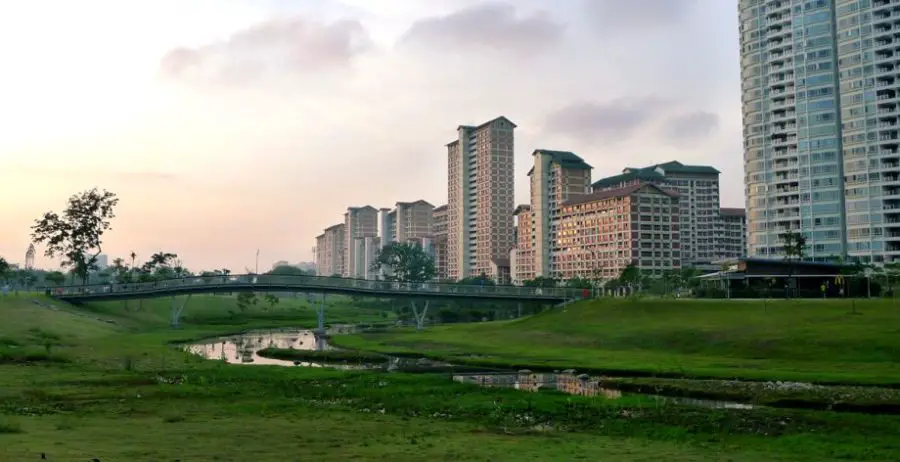
- Project Overview: Bishan-Ang Mo Kio Park in Singapore is a remarkable example of urban NbS. The project involved transforming a straight concrete drainage channel into a natural, meandering river. This initiative not only improved flood prevention and water quality but also reconnected park areas to the city.
- Impact Analysis:
- Environmental: The transformation led to improved biodiversity, with native wildlife returning to the area. The naturalization process also enhanced flood management and water quality.
-
- Economic: The project was cost-effective, with naturalization costing significantly less than rebuilding the concrete canal, and it brought additional recreational and aesthetic value to the city.
-
- Social: By bringing people closer to nature, the project positively impacted physical and mental well-being and increased community engagement with the environment.
- Lessons and Best Practices: Integrating natural materials, civil engineering techniques, and plants capable of filtering and absorbing water was key to the project’s success. This approach showcases the benefits of blending natural solutions with urban development needs.
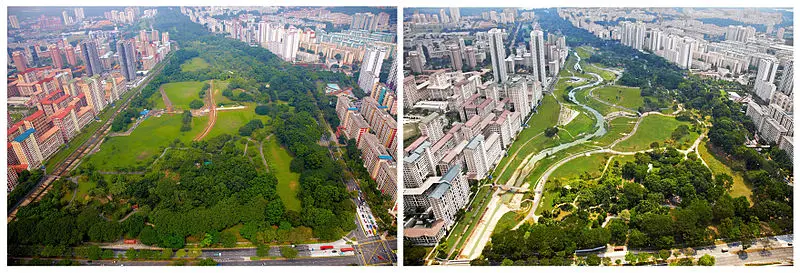
Other Notable Projects
- Green Corridors, Colombia: In Medellín, Colombia, the transformation of urban spaces into green corridors has significantly reduced air temperatures and mitigated the effects of urban heat islands.
- Rain Garden, Brazil: In Rio de Janeiro, the first rain garden at the Fundição Progresso Cultural Center demonstrated how incorporating nature into urban landscapes can manage stormwater runoff effectively.
Summary
These case studies exemplify the transformative power of Nature-Based Solutions in urban settings.
They highlight the multifaceted benefits of integrating natural elements into city landscapes, from environmental enhancements to socio-economic and health improvements.
These examples serve as blueprints for future NbS projects, offering insights into effective implementation strategies and the broad spectrum of benefits they can deliver.
For more detailed information on these and other case studies, you can explore the Nature-based Solutions case studies platform, which provides a comprehensive collection of best practice examples of NbS from around the world.
Also, ArchDaily’s article on 6 Urban Design Projects With Nature-Based Solutions offers insights into various successful urban NbS initiatives.
XII. Nature Based Solutions Conclusion
The Critical Role of NbS in Combating Climate Change:
Nature-based solutions (NbS) are more than just a buzzword in environmental circles; they are essential tools in our global arsenal against climate change.
Throughout this blog post, we have explored how NbS, from reforestation efforts to urban green initiatives, play a vital role in carbon sequestration, biodiversity conservation, and ecosystem resilience.
The case studies and examples discussed illustrate how NbS can effectively address the multifaceted challenges posed by climate change while offering socio-economic benefits.
The Need for Global Cooperation and Sustained Effort:
The battle against climate change is a global one, requiring concerted efforts from all corners of the world.
International policies like the Paris Agreement and initiatives like the Great Green Wall in Africa highlight the importance of global cooperation.
However, these efforts must be sustained and intensified. Countries, organizations, communities, and individuals must work together to implement, support, and scale NbS for a significant impact.
Call to Action for Readers:
Every individual has a role to play in supporting NbS. Here are some ways you can contribute:
- Educate and Advocate: Learn more about NbS and their benefits. Share this knowledge within your community and advocate for policies that support NbS.
- Support Local Initiatives: Participate in or support local NbS projects, such as community gardens, tree planting drives, or wetland restoration efforts.
- Make Sustainable Choices: Adopt more sustainable practices in your daily life, such as conserving water, reducing waste, and choosing sustainable products.
- Volunteer and Donate: Volunteer your time with organizations working on NbS or consider donating to support their efforts.
Final Thoughts:
Nature-based solutions and green infrastructure offer a pathway towards a more sustainable and resilient future.
By harnessing the power of nature, we can address the challenges of climate change while fostering biodiversity and enhancing the quality of life for communities worldwide.
It is a collective journey, and every step, no matter how small, counts towards making a significant impact.
Learn more: Carbon Insetting in Agriculture: A Nature-Based Solution
Learn more about: What Is Blue Infrastructure?
Learn more: Green vs Gray Infrastructure – Sustainably Forward
XIII. References and Further Reading
Throughout this blog post, various sources have been referenced to provide comprehensive information on Nature-Based Solutions (NbS).
Below is a list of these references for further reading and exploration:
- Nature-based Solutions Case Studies: A collection of best practice examples of NbS from around the globe. Nature-based Solutions case studies.
- ArchDaily – 6 Urban Design Projects With Nature-Based Solutions: An insightful article showcasing urban projects embodying NbS. ArchDaily Article.
- Nature Climate Change – Contribution of prioritized urban nature-based solutions allocation to carbon neutrality: A study exploring the contribution of NbS to achieving carbon neutrality in cities. Nature Climate Change Analysis.
- The Paris Agreement: Information on the international treaty on climate change. UNFCCC Paris Agreement.
- Global Environment Facility (GEF): An organization providing funding for environmental projects, including NbS. Global Environment Facility.
- Green Climate Fund (GCF): A fund supporting projects aimed at combating climate change. Green Climate Fund.
For additional resources and reading on Nature-Based Solutions, consider exploring the following:
- The Nature-Based Solutions Initiative: Offers a wealth of information on NbS, including research, policy development, and case studies. Nature-Based Solutions Initiative.
- The International Union for Conservation of Nature (IUCN): Provides extensive resources on conservation and NbS. IUCN.
- United Nations Environment Programme (UNEP): Offers insights and resources on environmental issues, including NbS. UNEP.
These references and additional resources offer a deeper understanding of Nature-Based Solutions and their role in addressing environmental challenges.
Check out our Nature Based Solutions blog category for more articles.
Read more: Why Is Green Infrastructure Important? 3 Big Reasons – Sustainably Forward







